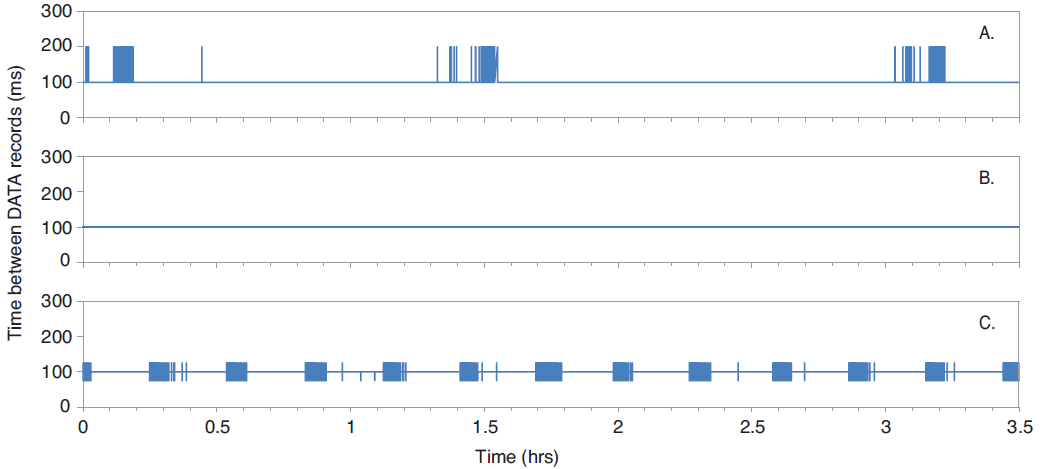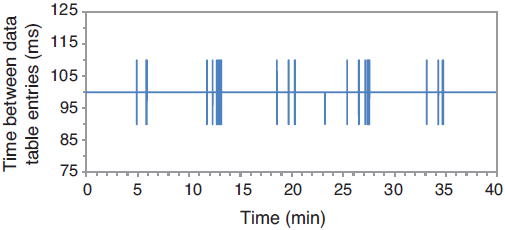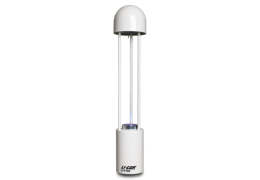Collecting Data from the LI-7700 on a CR3000 or CR1000 Datalogger
In this application note we describe methods for collecting the Ethernet output from an LI-7700 with Campbell Scientific, Inc. dataloggers. The example CRBasic code given here should be applicable to both the CR1000 and CR3000 dataloggers.
Networking
A physical network connection is required from the LI-7700 to the datalogger to allow data collection. On the LI-7700, the network connection is accessed through an eight-pin Turck® connector on the bottom of the instrument. Network connections for the CR1000 and CR3000 are accessed through the instrument’s peripheral port using Campbell Scientific NL115 Ethernet and CompactFlash® Module.
The LI-7700 and datalogger can be connected directly together or via a local area network, but a direct connection is recommended. Direct connections eliminate the possibility of additional network traffic, which can slow data transfer and lead to missed data packets by the logger. However they are connected, the logger and the LI-7700 should be configured to operate with static IP addresses on the same subnet. An example network configuration is given in Table 1.
Within the datalogger program, the logger’s IP port must be enabled and configured to look for data packets sent from the LI-7700’s IP address. This is done using the TCPOpen command, which is given below:
Public tcpip_socket_status As Long
Dim socket As Long
BeginProg
TCPClose (101)
Scan (100,mSec,300,0)
…
NextScan
SlowSequence
Scan (5,Sec,3,0)
tcpip_socket_status = SerialInChk (socket)
If (tcpip_socket_status = -1) Then
socket = TCPOpen (“172.24.23.61”,7700,527)
EndIf
NextScanThe value 7700 in the TCPOpen command is the IP port where the LI-7700 is located. This is set at the factory for the instrument and will always be 7700. The IP address of this LI-7700 is 172.24.23.61 and is set by the user in the Manual Controls window of the instrument’s Windows® interface software. For the datalogger to talk to the LI-7700 the first three octets of their IP addresses should match (e.g. 172.24.23. nn), but the last octet must be unique to each device. The subnet mask and gateway should be set the same on both devices.
Data output and collection
Data output from the LI-7700 is in the form of tab delimited ASCII text strings followed by a line feed (Figure 1). Upon connecting to the instrument, a set of headers containing labels for the variables included in each record type are sent from the LI-7700 to the datalogger. DATAH and DATASTATH list the variables included in the DATA and DATASTAT records, respectively. Any time the output rate is set to a value greater than zero, new DATA records will be output at the current output rate. DATASTAT is turned off by default in the LI-7700, but if needed it can be enabled by sending the command:
<licor><li7700><output><status>true</status></output></li7700></licor>followed by a line feed. The maximum output frequency for DATASTAT is fixed at 2Hz. When the instrument’s output rate is configured for greater than 2Hz, a DATASTAT record will not be output following each DATA record. Most variables included in the DATASTAT record are duplicated by flags in the diagnostic variable included in each DATA record, so it is generally not necessary to continuously collect DATASTAT. DATASTAT is most useful for troubleshooting purposes.

When the output rate is set to a value greater than zero, new DATA records are continuously output from the LI-7700. With the instrument configured this way, the datalogger can be set up to act like a terminal that captures each new DATA record, as in the example code given below:
Public LI7700_time(3) As Long
Public LI7700(22)
Public tcpip_socket_status As Long
Dim socket As Long
Dim DATA_string As String * 237
Dim NBR As Long
DataTable (Ethernet_data,TRUE,-1)
Sample (3,LI7700_time(1),Long)
Sample (19,LI7700(4),IEEE4)
EndTable
BeginProg
TCPClose (101)
Scan (10,mSec,300,0)
SerialInRecord (socket,DATA_string,&h44,0,&h0A,NBR,01)
SplitStr (LI7700_time(1),DATA_string,CHR(09),3,4)
SplitStr (LI7700(1),DATA_string,CHR(09),22,4)
If NBR>0 Then
CallTable Ethernet_data
EndIf
NextScan
SlowSequence
Scan (5,Sec,3,0)
tcpip_socket_status = SerialInChk (socket)
If (tcpip_socket_status = -1) Then
socket = TCPOpen (“172.24.23.61”,7700,527)
EndIf
NextScanIn this example, SerialInRecord looks for ASCII strings starting with “D” (&h44) to define when to start writing data to the variable DATA_string. SplitStr then parses out individual data points from DATA_string based the occurrence of tab charters (CHR(09)) in the ASCII string. The first three values included in the DATA record sent from the LI-7700 are 32 bit time stamps. These must be treated differently from the rest of the variables parsed from DATA_string, otherwise when the datalogger converts them from string to numeric variables they will be rounded to 24 bits by default.
The scan interval used in this example, Scan (10,mSec,300,0), is much faster than the rate at which DATA records would normally be collected and the variables resulting from SplitStr are only written to the data table when a new record is received. Data from the LI-7700 should be collected this way because of timing asynchrony between the instrument and the datalogger. In a continuous data collection mode the timing between DATA records is controlled by the LI-7700, but the time between collecting DATA records is controlled by the scan interval of the logger. For a DATA record to be successfully collected by the logger, the record must be output within a certain window when the execution of a scan occurs. Since time keeping is handled separately by the two devices there is no mechanism ensuring this will happen. By using a scan interval that is much faster than the output rate of the LI-7700 the likelihood of missing a record is significantly reduced (Figure 3).
The LI-7700 also supports a polled mode, where the datalogger requests a new DATA record with each scan. When polled, the LI-7700 will return the next DATA record collected by the instrument at its base rate (40Hz) after the poll command is received. This will result in a baseline jitter in the data of 25 milliseconds (Figure 3C).
Polling is enabled by setting the output rate to zero and sending the command:
<licor><li7700><cmd><poll>true
</poll></cmd></li7700></licor>
followed by a line feed whenever a new DATA record is desired.
The SerialOutBlock instruction can be used to issue the string and should be placed in the main datalogger program following the SerialInRecord instruction, as given on the following page.

Public LI7700_time(3) As Long
Public LI7700(22)
Public tcpip_socket_status As Long
Dim socket As Long
Dim DATA_string As String * 237
Dim NBR As Long
DataTable (Ethernet_data,TRUE,-1)
DataInterval (0,0,Sec,100)
Sample (3,LI7700_time(1),Long)
Sample (19,LI7700(4),IEEE4)
EndTable
BeginProg
TCPClose (101)
Scan (100,mSec,300,0)
SerialInRecord (socket,DATA_string,&h44,0,&h0A,NBR,01)
SerialOutBlock(socket,”<licor><li7700><cmd><poll>true</poll></cmd></li7700></licor>”+CHR(10),61)
SplitStr (LI7700_time(1),DATA_string,CHR(09),3,4)
SplitStr (LI7700(1),DATA_string,CHR(09),22,4)
CallTable Ethernet_data
NextScan
SlowSequence
Scan (5,Sec,3,0)
tcpip_socket_status = SerialInChk (socket)
If (tcpip_socket_status = -1) Then
socket = TCPOpen (“172.24.23.61”,7700,527)
EndIf
NextScanAuxiliary sensor data
There are four single ended analog input channels and three thermocouple input channels available on the LI-7700. In applications where it is necessary to have auxiliary sensor data synchronized with the data from the LI-7700 (e.g. wind speed data in an eddy covariance application), the sensor should be connected via these inputs. This will compensate for the clock asynchrony between the datalogger and LI-7700, ensuring that the auxiliary sensor is sampled at the same rate as the LI-7700.
It is important to note that the sensor should be connected directly to the LI-7700, whether operating in polled mode where timing jitter is obvious between records, or when operating in continuous mode with conditional sampling even though there is no jitter between DATA records. This is because in continuous mode, there is an apparent drift in the time between when DATA records are written to the final storage table, which is equal to the scan interval. In the example used here, the datalogger’s time stamp shows a 10 ms jitter roughly every five minutes (Figure 3). Using the LI-7700 as the primary interface for the auxiliary sensor ensures this jitter does not affect data quality.
Note: If adding the LI-7700 to a flux station where carbon dioxide and water vapor are measured, it may be necessary to split the output from the sonic anemometer so that it can be sampled by both the datalogger directly and the LI-7700.

Appendix A
Example CRBasic program for unprompted data collection. The example code can be copied and pasted directly into CRBasic, and should compile correctly for both the CR1000 and CR3000.
PipeLineMode
Const Output_interval = 30 ‘Diagnostic data table output interval.
Const Buffer_Size = 527
Const NBE = 237 ‘Number of bytes expected
Public LI7700_time(3) As Long
Public LI7700(22)
Public diag_bits(16) As Boolean
Public tcp_close As Boolean
Public tcp_open As Boolean
Public tcpip_socket_status As Long
Alias LI7700_time(1) = milliseconds
Alias LI7700_time(2) = seconds
Alias LI7700_time(3) = nanoseconds
Alias LI7700(4) = Diagnostic
Alias LI7700(5) = CH4_density
Alias LI7700(6) = CH4_mole_fraction
Alias LI7700(7) = Temperature
Alias LI7700(8) = Pressure
Alias LI7700(9) = RSSI
Alias LI7700(10) = Drop_rate
Alias LI7700(11) = Aux(8)
Alias LI7700(19) = TC(3)
Alias LI7700(22) = DATA_checksum
Alias diag_bits(1) = box_connected
Alias diag_bits(2) = bad_aux_tc3
Alias diag_bits(3) = bad_aux_tc2
Alias diag_bits(4) = bad_aux_tc1
Alias diag_bits(5) = motor_failure
Alias diag_bits(6) = calibrating
Alias diag_bits(7) = bottom_heater_on
Alias diag_bits(8) = top_heater_on
Alias diag_bits(9) = pump_on
Alias diag_bits(10) = motor_spinning
Alias diag_bits(11) = block_tmpr_unregulated
Alias diag_bits(12) = laser_tmpr_unregulated
Alias diag_bits(13) = bad_tmpr
Alias diag_bits(14) = ref_unlocked
Alias diag_bits(15) = no_signal
Alias diag_bits(16) = not_ready
Units milliseconds = ms
Units seconds = s
Units nanoseconds = ns
Units CH4_density = mmol/m^3
Units CH4_mole_fraction = umol/mol
Units Temperature = C
Units Pressure = kPa
Units RSSI = %
Units Drop_rate = %
Units TC() = C
Dim socket As Long
Dim DATA_string As String * NBE
Dim NBR As Long ‘Number of bytes returned in DATA_string
Dim checksum_datalogger
Dim checksum_flag As Boolean
Dim diag_work As Long
Dim n
DataTable (Ethernet_data,TRUE,-1)
Sample (3,milliseconds,Long)
Sample (19,Diagnostic,IEEE4)
Sample (1,checksum_datalogger,IEEE4)
EndTable
DataTable (Diagnostic_flags,TRUE,-1)
DataInterval (0,Output_interval,Min,100)
FieldNames (“nnd_7700_Tot”)’No new data (sensor not connected or powered)
Totalize (1,n,IEEE4,NBR<>0 IMP checksum_flag)
FieldNames (“checksum_err_7700_TOT”)’Checksum error
Totalize (1,n,IEEE4,checksum_flag IMP NOT (box_connected))
FieldNames (“box_connected _TOT”)’LI-7550 connected or not
Totalize (1,n,IEEE4,checksum_flag IMP NOT (bad_aux_tc3))
FieldNames (“bad_aux_tc3_TOT”)’Bad reading at TC3
Totalize (1,n,IEEE4,checksum_flag IMP NOT (bad_aux_tc2))
FieldNames (“bad_aux_tc2_TOT”)’Bad reading at TC2
Totalize (1,n,IEEE4,checksum_flag IMP NOT (bad_aux_tc1))
FieldNames (“bad_aux_tc1_TOT”)’Bad reading at TC1
Totalize (1,n,IEEE4,checksum_flag IMP NOT (motor_failure))
FieldNames (“motor_failure_TOT”)’Mirror spin motor failure
Totalize (1,n,IEEE4,checksum_flag IMP NOT (calibrating))
FieldNames (“calibrating_TOT”)’Calibration routine enabled
Totalize (1,n,IEEE4,checksum_flag IMP NOT (bottom_heater_on))
FieldNames (“bottom_heater_on_TOT”)’Bottom mirror heater on
Totalize (1,n,IEEE4,checksum_flag IMP NOT (top_heater_on))
FieldNames (“top_heater_on_TOT”)’Top mirror heater on
Totalize (1,n,IEEE4,checksum_flag IMP NOT (pump_on))
FieldNames (“pump_on_TOT”)’Washer pump activated
Totalize (1,n,IEEE4,checksum_flag IMP NOT (motor_spinning))
FieldNames (“motor_spinning_TOT”)’Bottom mirror spinning
Totalize (1,n,IEEE4,checksum_flag IMP NOT (block_tmpr_unregulated))
FieldNames (“block_tmpr_unregulated_TOT”)’Block temp not at set point
Totalize (1,n,IEEE4,checksum_flag IMP NOT (laser_tmpr_unregulated)))
FieldNames (“laser_tmpr_unregulated_TOT”)’Laser temp not at set point
Totalize (1,n,IEEE4,checksum_flag IMP NOT (bad_tmpr))
FieldNames (“bad_tmpr_TOT”)’Bad TC in optical path
Totalize (1,n,IEEE4,checksum_flag IMP NOT (ref_unlocked))
FieldNames (“ref_unlocked_TOT”)’Reference signal not line locked
Totalize (1,n,IEEE4,checksum_flag IMP NOT (no_signal))
FieldNames (“no_signal_TOT”)’No laser signal detected
Totalize (1,n,IEEE4,checksum_flag IMP NOT (not_ready))
FieldNames (“not_ready_TOT”)’LI-7700 not ready
EndTable
BeginProg
TCPClose (101)
n = 1
Scan (10,mSec,300,0)
SerialInRecord (socket,DATA_string,&h44,0,&h0A,NBR,01)
SplitStr (LI7700_time(1),DATA_string,CHR(09),3,4)
SplitStr (LI7700(1),DATA_string,CHR(09),22,4)
checksum_flag = (DATA_checksum EQV (CheckSum (“D”&DATA_string,7,NBR-2)))
checksum_datalogger = CheckSum (“D”&DATA_string,7,NBR-2)
‘Break up the Diagnostic into 16 separate bits.
If ( (NBR <> 0) AND (checksum_flag) ) Then
diag_work = Diagnostic
box_connected = diag_work AND &h0001
bad_aux_tc3 = diag_work AND &h0002
bad_aux_tc2 = diag_work AND &h0004
bad_aux_tc1 = diag_work AND &h0008
motor_failure = diag_work AND &h0010
calibrating = diag_work AND &h0020
bottom_heater_on = diag_work AND &h0040
top_heater_on = diag_work AND &h0080
pump_on = diag_work AND &h0100
motor_spinning = diag_work AND &h0200
block_tmpr_unregulated = diag_work AND &h0400
laser_tmpr_unregulated = diag_work AND &h0800
bad_tmpr = diag_work AND &h1000
ref_unlocked = diag_work AND &h2000
no_signal = diag_work AND &h4000
not_ready = diag_work AND &h8000
Else
Move (milliseconds,3,-99999,1)
Move (LI7700(1),21,NaN,1)
Move (diag_bits(1),16,TRUE,1)
EndIf
If NBR<>0 Then
CallTable Ethernet_data
EndIf
CallTable Diagnostic_flags
NextScan
SlowSequence
Scan (5,Sec,3,0)
tcpip_socket_status = SerialInChk (socket)
If ( tcp_close ) Then
tcp_close = FALSE
TCPClose (socket)
EndIf
If ( (tcpip_socket_status = -1) OR tcp_open) Then
tcp_open = FALSE
socket = TCPOpen (“172.24.23.61”,7700,Buffer_size)
EndIf
NextScanAppendix B
Example CRBasic program for polled data collection. The example code can be copied and pasted directly into CRBasic, and should compile correctly for both the CR1000 and CR3000.
PipeLineMode
‘Measurement Rate 5 Hz 10 Hz 20 Hz
Const Scan_interval = 100 ‘200 mSec 100 mSec 50 mSec
Const Output_interval = 30 ‘Diagnostic data table output interval.
Const Buffer_Size = 527
Const NBE = 237 ‘Number of bytes expected
Public LI7700_time(3) As Long
Public LI7700(22)
Public diag_bits(16) As Boolean
Public tcpip_socket_status As Long
Alias LI7700_time(1) = milliseconds
Alias LI7700_time(2) = seconds
Alias LI7700_time(3) = nanoseconds
Alias LI7700(4) = Diagnostic
Alias LI7700(5) = CH4_density
Alias LI7700(6) = CH4_mole_fraction
Alias LI7700(7) = Temperature
Alias LI7700(8) = Pressure
Alias LI7700(9) = RSSI
Alias LI7700(10) = Drop_rate
Alias LI7700(11) = Aux(8)
Alias LI7700(19) = TC(3)
Alias LI7700(22) = DATA_checksum
Alias diag_bits(1) = box_connected
Alias diag_bits(2) = bad_aux_tc3
Alias diag_bits(3) = bad_aux_tc2
Alias diag_bits(4) = bad_aux_tc1
Alias diag_bits(5) = motor_failure
Alias diag_bits(6) = calibrating
Alias diag_bits(7) = bottom_heater_on
Alias diag_bits(8) = top_heater_on
Alias diag_bits(9) = pump_on
Alias diag_bits(10) = motor_spinning
Alias diag_bits(11) = block_tmpr_unregulated
Alias diag_bits(12) = laser_tmpr_unregulated
Alias diag_bits(13) = bad_tmpr
Alias diag_bits(14) = ref_unlocked
Alias diag_bits(15) = no_signal
Alias diag_bits(16) = not_ready
Units milliseconds = ms
Units seconds = s
Units nanoseconds = ns
Units CH4_density = mmol/m^3
Units CH4_mole_fraction = umol/mol
Units Temperature = C
Units Pressure = kPa
Units RSSI = %
Units Drop_rate = %
Units TC() = C
Dim socket As Long
Dim DATA_string As String * NBE
Dim NBR As Long ‘Number of bytes returned in DATA_string
Dim checksum_datalogger
Dim checksum_flag As Boolean
Dim diag_work As Long
Dim n
DataTable (Ethernet_data,TRUE,-1)
DataInterval (0,0,Sec,100)
Sample (3,milliseconds,Long)
Sample (19,Diagnostic,IEEE4)
Sample (1,checksum_datalogger,IEEE4)
EndTable
DataTable (Diagnostic_flags,TRUE,-1)
DataInterval (0,Output_interval,Min,100)
FieldNames (“nnd_7700_Tot”)’No new data (sensor not connected or powered)
Totalize (1,n,IEEE4,NBR<>0 IMP checksum_flag)
FieldNames (“checksum_err_7700_TOT”)’Checksum error
Totalize (1,n,IEEE4,checksum_flag IMP NOT (box_connected))
FieldNames (“box_connected _TOT”)’LI-7550 connected or not
Totalize (1,n,IEEE4,checksum_flag IMP NOT (bad_aux_tc3))
FieldNames (“bad_aux_tc3_TOT”)’Bad reading at TC3
Totalize (1,n,IEEE4,checksum_flag IMP NOT (bad_aux_tc2))
FieldNames (“bad_aux_tc2_TOT”)’Bad reading at TC2
Totalize (1,n,IEEE4,checksum_flag IMP NOT (bad_aux_tc1))
FieldNames (“bad_aux_tc1_TOT”)’Bad reading at TC1
Totalize (1,n,IEEE4,checksum_flag IMP NOT (motor_failure))
FieldNames (“motor_failure_TOT”)’Mirror spin motor failure
Totalize (1,n,IEEE4,checksum_flag IMP NOT (calibrating))
FieldNames (“calibrating_TOT”)’Calibration routine enabled
Totalize (1,n,IEEE4,checksum_flag IMP NOT (bottom_heater_on))
FieldNames (“bottom_heater_on_TOT”)’Bottom mirror heater on
Totalize (1,n,IEEE4,checksum_flag IMP NOT (top_heater_on))
FieldNames (“top_heater_on_TOT”)’Top mirror heater on
Totalize (1,n,IEEE4,checksum_flag IMP NOT (pump_on))
FieldNames (“pump_on_TOT”)’Washer pump activated
Totalize (1,n,IEEE4,checksum_flag IMP NOT (motor_spinning))
FieldNames (“motor_spinning_TOT”)’Bottom mirror spinning
Totalize (1,n,IEEE4,checksum_flag IMP NOT (block_tmpr_unregulated))
FieldNames (“block_tmpr_unregulated_TOT”)’Block temp not at set point
Totalize (1,n,IEEE4,checksum_flag IMP NOT (laser_tmpr_unregulated)))
FieldNames (“laser_tmpr_unregulated_TOT”)’Laser temp not at set point
Totalize (1,n,IEEE4,checksum_flag IMP NOT (bad_tmpr))
FieldNames (“bad_tmpr_TOT”)’Bad TC in optical path
Totalize (1,n,IEEE4,checksum_flag IMP NOT (ref_unlocked))
FieldNames (“ref_unlocked_TOT”)’Reference signal not line locked
Totalize (1,n,IEEE4,checksum_flag IMP NOT (no_signal))
FieldNames (“no_signal_TOT”)’No laser signal detected
Totalize (1,n,IEEE4,checksum_flag IMP NOT (not_ready))
FieldNames (“not_ready_TOT”)’LI-7700 not ready
EndTable
BeginProg
TCPClose (101)
n = 1
Scan (Scan_interval,mSec,300,0)
SerialInRecord (socket,DATA_string,&h44,0,&h0A,NBR,01)
SerialOutBlock (socket,”<licor><li7700><cmd><poll>true</poll></cmd></li7700></licor>”+CHR(10),61)
SplitStr (LI7700_time(1),DATA_string,CHR(09),3,4)
SplitStr (LI7700(1),DATA_string,CHR(09),22,4)
checksum_flag = (DATA_checksum EQV (CheckSum (“D”&DATA_string,7,NBR-2)))
checksum_datalogger = CheckSum (“D”&DATA_string,7,NBR-2)
‘Break up the Diagnostic into 16 separate bits.
If ( (NBR <> 0) AND (checksum_flag) ) Then
diag_work = Diagnostic
box_connected = diag_work AND &h0001
bad_aux_tc3 = diag_work AND &h0002
bad_aux_tc2 = diag_work AND &h0004
bad_aux_tc1 = diag_work AND &h0008
motor_failure = diag_work AND &h0010
calibrating = diag_work AND &h0020
bottom_heater_on = diag_work AND &h0040
top_heater_on = diag_work AND &h0080
pump_on = diag_work AND &h0100
motor_spinning = diag_work AND &h0200
block_tmpr_unregulated = diag_work AND &h0400
laser_tmpr_unregulated = diag_work AND &h0800
bad_tmpr = diag_work AND &h1000
ref_unlocked = diag_work AND &h2000
no_signal = diag_work AND &h4000
not_ready = diag_work AND &h8000
Else
Move (milliseconds,3,-99999,1)
Move (LI7700(1),21,NaN,1)
Move (diag_bits(1),16,TRUE,1)
EndIf
CallTable Ethernet_data
CallTable Diagnostic_flags
NextScan
SlowSequence
Scan (5,Sec,3,0)
tcpip_socket_status = SerialInChk (socket)
If ( tcpip_socket_status = -1) Then
socket = TCPOpen (“172.24.23.61”,7700,Buffer_size)
EndIf
NextScan